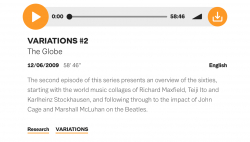VARIATIONS #2. The Globe

Type
Audio/Visual
Authors
Leidecker ( Jon Leidecker )
Category
Podcast
[ Browse Items ]
Publication Year
2009
URL
[ private ]
Duration
58:46
Tags
Abstract
Variations is a seven part series history of appropriative collage in music, compositions made using recordings of older ones. It's a practice that in the '80s became known sampling — after the digital sampler — a breakthrough instrument which was designed to mimic traditional musical instruments by allowing the player to trigger recordings of them back on a keyboard. But it didn't take long for musicians to realize that the true strength of the sampler was the way in which it made it easy easy to collage and manipulate the best sounds from their favorite records into new pieces of music. This practice entered the popular mainstream by the 80s, long after observers had already identified collage as the defining new art form of the 20th century — and the roots of this music go back just as far. Over the course of this series, Leidecker looks at these roots, as appropriative collage developed across experimental and mainstream paths.
The second episode of this series presents an overview of the sixties, starting with the world music collages of Richard Maxfield, Teiji Ito and Karlheinz Stockhausen, and following through to the impact of John Cage and Marshall McLuhan on the Beatles.
If music initially hesitated to follow the lead of the visual arts in the field of collage, it made up for lost time in the sixties. Breakthroughs in high fidelity sound, an influx of consumer level tape recorders, and the continued influence of television building the notion of the Global Village were among the factors that led to an explosion in collage based composition. The most obvious of the shared qualities in these pieces was a tendency towards the use of World music, culled from as many disparate locations as possible. If the new availability of ethnological recordings from around the world had shattered the notion that music was a universal language, musical collage can be seen as an instant response to the rest of the world as it became unignorable – a way to explore things held in common and the potential for hybrid identities.
The second episode of this series presents an overview of the sixties, starting with the world music collages of Richard Maxfield, Teiji Ito and Karlheinz Stockhausen, and following through to the impact of John Cage and Marshall McLuhan on the Beatles.
If music initially hesitated to follow the lead of the visual arts in the field of collage, it made up for lost time in the sixties. Breakthroughs in high fidelity sound, an influx of consumer level tape recorders, and the continued influence of television building the notion of the Global Village were among the factors that led to an explosion in collage based composition. The most obvious of the shared qualities in these pieces was a tendency towards the use of World music, culled from as many disparate locations as possible. If the new availability of ethnological recordings from around the world had shattered the notion that music was a universal language, musical collage can be seen as an instant response to the rest of the world as it became unignorable – a way to explore things held in common and the potential for hybrid identities.
Description
https://ubu.com/sound/leidecker.html
Number of Copies
1
| Library | Accession No | Call No | Copy No | Edition | Location | Availability |
|---|---|---|---|---|---|---|
| Main | 316 | 1 | Yes |